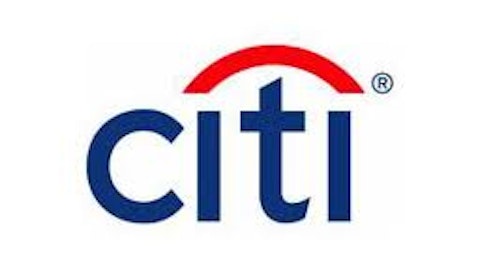A quick check of Capital One Financial Corp. (NYSE:COF)‘s top-line revenue reveals a dramatic change from the second quarter of 2012 to the second quarter of 2013:

Source: Company SEC filings.
Its 44% revenue growth year over year bested regional banking counterparts PNC Financial Services (NYSE:PNC) and U.S. Bancorp (NYSE:USB), which clocked in at 15% and -0.4%, respectively. It also topped the nation’s largest bank, JPMorgan Chase & Co. (NYSE:JPM), which saw revenue grow at 14%.

Source: S&P Capital IQ
How did Capital One Financial Corp. (NYSE:COF) generate that amazing growth? Let’s take a closer look.
Sources of Revenue
Banks generate revenue from two major sources: interest and non-interest income. Banks make interest income from loans to consumers and companies, while non-interest income comes from fees, trust and asset management services, and other ancillary activities.
An enormous percentage of Capital One Financial Corp. (NYSE:COF)’s revenue comes from the basic banking operations of interest income, rather than extra fees or special services.
| Revenue Type | Capital One | PNC | US Bancorp |
|---|---|---|---|
| Interest Income | 82% | 58% | 57% |
| Non-interest Income | 18% | 42% | 43% |
Source: SEC filings.
Over the past year, Capital One Financial Corp. (NYSE:COF) has seen impressive growth in its interest income from other loans and investments. That slice of its revenue has risen by 9%, while peers U.S. Bancorp (NYSE:USB) and PNC Financial Services (NYSE:PNC) have each seen their interest income fall over the past year.

Source: S&P Capital IQ
Still, remember that Capital One Financial Corp. (NYSE:COF) gets far more of its revenue from this interest income than its two rivals. To get a complete picture of these businesses’ growth, you also need to see how their non-interest income has measured up:

Source: S&P Capital IQ

How does 9% + 3% = 44%?
As we saw earlier, Capital One Financial Corp. (NYSE:COF)’s interest income grew by 9%, and its non-interest income increased by 3%. But how did those two numbers combine to equal the 44% growth in its total revenue? The answer lies in an often-overlooked income-statement line item.
“Provision for Credit Losses” is a forward-looking estimate of what the bank expects to lose on its loans; this number gets subtracted from a bank’s total revenue calculation.
If a bank has flat interest and non-interest income, but its provision for loan losses goes down, its total revenue will rise. In the last year, Capital One Financial Corp. (NYSE:COF) has seen its provision for credit losses plummet by more than $1 billion as the result of a safer, less-risky business climate, and the removal of a one-time charge. These lowered loss provisions have directly contributed to the company’s revenue.

Source: S&P Capital IQ
Capital One Financial Corp. (NYSE:COF)’s falling provisions for credit losses and rising revenue certainly look appealing. But you’ll get a clearer picture of any bank’s top-line growth by looking at its revenue before the provision for credit losses.
That figure is a more telling measure for a bank because it removes any accounting alterations, and instead displays the actual growth in its current operations.
In this light, Capital One Financial Corp. (NYSE:COF)’s growth looks significantly less dramatic:
Not so fast
| Company | Q2 2012 | Q2 2013 | % Change |
|---|---|---|---|
| Capital One | $5,055 | $5,638 | 12% |
| PNC | $3,623 | $4,020 | 11% |
| US Bancorp | $4,893 | $4,765 | -3% |
Source: S&P Capital IQ. In millions.
Here we see that Capital One Financial Corp. (NYSE:COF)’s growth clocked in at a much more tepid pace of 12%. Again, PNC Financial Services (NYSE:PNC)’s growth looks more dramatic to do a one-time charge in the second-quarter of last year.
While revenue growth alone doesn’t drive most investors’ decisions, 44% top-line growth will definitely draw their attention. However, you’ll need to take a closer look at the numbers to see whether that apparent growth matches up to reality.
The article The 1 Income Statement Number You Shouldn’t Ignore originally appeared on Fool.com.
Patrick Morris owns shares of US Bancorp. The Motley Fool owns shares of PNC Financial Services (NYSE:PNC).
Copyright © 1995 – 2013 The Motley Fool, LLC. All rights reserved. The Motley Fool has a disclosure policy.





